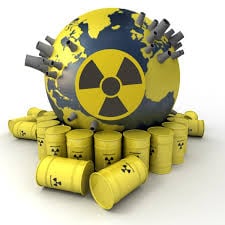Finland's government approved the construction of the world's first permanent repository for storing nuclear waste. The $3.2 billion facility, which will hold up to 6,500 tons of uranium for 100,000 years underground, will become operational in 2023 on Olkiluoto, an island off Finland’s west coast.
HIGH ACTIVITY LEVEL RADIOACTIVE WASTE
High-level radioactive wastes are the highly radioactive materials produced as a byproduct of the reactions that occur inside nuclear reactors,
explains BCC Research analyst Nikos Thomopoulos.
“High-level wastes take one of two forms. Spent (used) nuclear reactor fuel when it is accepted for disposal and radioactive waste materials remaining after spent fuel are reprocessed,” say Thomopoulos. “High-level wastes are extremely hazardous because they produce fatal radiation doses during short periods of direct exposure. Disposal in deep, stable geological formations usually several hundred meters or more below the surface is the generally recognized option for disposal of HLW.”
GEOLOGIC DISPOSAL
The basic concept of geological disposal is to locate a large, stable geologic formation and use mining technology to excavate a tunnel, or large-bore tunnel boring machines to drill a shaft of a length between 500 meters and 1,000 meters below the surface. In this shaft, rooms or vaults can be excavated for disposal of high level activated radioactive waste.
The goal is to permanently isolate nuclear waste from the human environment, according to Thomopoulos. Many people remain uncomfortable with the immediate stewardship cessation of this disposal system, suggesting perpetual management and monitoring would be more prudent. The process of selecting appropriate deep final repositories for high-level waste and spent fuel is now under way in several countries.
In Finland’s repository, the uranium will be packed in copper-coated canisters lodged in a network of tunnels cut from granite bedrock at a depth of 1,300-1,480 feet below ground, according to
phys.org. The tunnels will be sealed with a buffer of bentonite clay, a volcanic ash that swells when mixed with water. containers will be packed in with clay. After the facility is sealed, in 2120 Finnish authorities estimate, the repository should safely isolate the waste for several hundred thousand years, when radiation levels will have dissipated.
Finland's Economy Minister Olli Rehn, said at a press conference: "This is the world's first authorisation for the final repository of used nuclear waste. Finland is an international pioneer in nuclear waste management, which also obliges us to take care of matters responsibly and safely in future. Finnish expertise also provides us with commercial opportunities in developing nuclear waste management in other countries."
Posiva Oy, a Finnish company jointly owned by two Finnish nuclear utilities, expects to begin the construction of the waste management site in 2016.
"The construction licence that has now been granted for our final disposal facility for used nuclear fuel is a significant achievement for us, our owners and our entire personnel,” says Posiva CEO Janne Mokka. “This pioneering project is important not only for Finland, but also on a global scale. It is the first project entering into construction phase in the whole world."
A similar project is under way in Sweden, where a final decision on the construction hasn't been made. Besides Sweden,
notes Elizabeth Gibney, the French nuclear-waste agency ANDRA hopes to apply in 2017 for a license to build a facility in Bure. This would use a different technology designed for clay rocks, which stores waste by blending it into molten glass.
HIGH-LEVEL RADIOACTIVE WASTE PRODUCTION IN EUROPE
High-level radioactive waste production in European countries was estimated at a total
quantity of nearly 11,300 cubic meters in 2014,
reports Thomopoulos. Based on data from governmental services and statistical sources, he estimates that high-level radioactive waste production will expand by almost 4% in 2015 to 11,700 cubic meters. This growth is expected to continue through 2020 and reach 13,700 cubic meters. The estimated five-year CAGR is equivalent to 3.2%.




